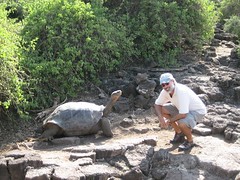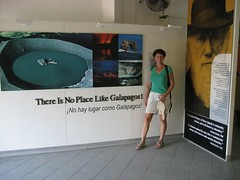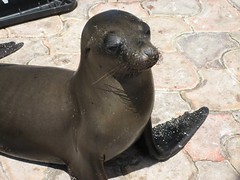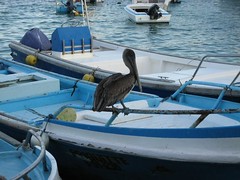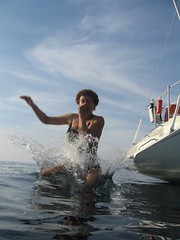Monday, April 9.
We are still in Puerto Villamil seeing some sights and
preparing for the longest sail of our life. On Saturday, we
checked out the municipal pier and met out new neighbors in the
anchorage — Karyn (French) and Jean-Pierre (Swiss). They have
been circumnavigating for ten years but have only gotten as far
as the Galapagos. They have a beautiful Catana 471 (“Intiac”,
named after their grandchildren) and will be leaving for the
Pacific crossing about the same time as we will. Without
Laura’s French language skills we could not struck up this nice
friendship. In the afternoon, we took a taxi into the national
park and did some short hikes. The taxi (a pickup truck) took
us to each trail head and waited as we hiked. The landscape is
bleak vocanic rock that heats up incredibly in the equatorial
sun. We never seem to get an early start so it is pretty hot on
land once we get going. We hiked to the “wall of tears” which
is all that remains of a prison that had an atrocious reputation
in its years of operation. We also hiked up to a “mirador”
(viewpoint) on top of a volcanic hill, and to a lava tunnel
leading into the ocean.
Sunday we hired Gonzolo, a national park guide, to take us
up to volcano Sierra Negra. This involved taking his pick-up
truck up a very dusty dirt road for an hour and then hiking a
short distance to the second largest volcanic crater in the
world. It was impressive to see and hotter than hell. We had
lunch with Ozkan Gulkanak of “Kayitsiz”. Ozkan is a young
Turkish guy who is single-handing a wooden 28 foot boat of his
own design. He is a very gregarious character who, it seems, is
known by everyone on sail boats in the Galapagos. We asked him
how he keeps a safe watch when sailing alone and he said that he
is not worried about collision. When we returned to the boat
late in the afternoon, we saw our friends Michael and Britta on
“Vera” enter the bay and anchor next to us. Vera is the boat
that we met sailing from Bonaire to the San Blas Islands, and we
spent some time with them in Panama. To our surprise (and
theirs), an Ecuadorian navy officer came to their boat soon
after they anchored (on Easter Sunday), and said that they must
report to the Capitan del Puerto by 7 am. The reason is that
they were flying the German flag and the German boats that left
here on Friday and Saturday apparently did so without following
the check-in procedures and paying their fees.
Today, we found an internet cafe and tried to catch up on
email but the connection speeds were abysmal. We met Michael
and Britta and had a long lunch catching up on events since we
last saw them at Isla Grande, Panama. We asked them if they had
met Ozkan, the single-handing Turk anchored in front of us, and
it turns out they did. When approaching the Galapagos in the
fog two weeks ago, Ozkan’s boat almost ran into “Vera” while
Ozkan was asleep. Britta had to use her fog horn to awaken him.
This was the only boat that “Vera” saw on her crossing from
Panama. Small ocean.
After lunch, Laura and I took a wonderful excursion by boat
to “La Tintoreras”, the black lava shoals and islands and form
one boundary of the anchorage. We had an excellent guide
(guides are required) and were able to see Galapagos penguins,
boobies, marine iguanas, sharks, rays, sea lions and more. Part
of the excursion is a walk on paths cut into the jagged black
vocanic rock of “La Tintoreras.” There are long, deep fissures
in the rock filled with sea water and at least 50 white-tipped
sharks (known as “tintoreras” in Spanish). After the walk, we
snorkeled off the excursion boat and got to swim with sea lions.
Our guide had a fish chart with him in the water and would
point to fish and then to its picture and name in the chart as
we snorkeled.
This was our last tour in the Galapagos. Tomorrow will be
devoted to final preparations for our big sail to Nuka Hiva in
the Marquesas. The weather forecast is not very good — there
is no wind nearby and none coming anytime soon. We downloaded
a wind forecast as a GRIB file that has the tradewinds starting
south of 5 degrees south latitude. Other cruisers on the way to
the Marquesas have called in on the SSB radio to confirm that
they needed to motor past 5 degrees, one said as far as 8
degrees south, to get good tradewinds. It is a day and one-half
of motoring for us to get down to 5 degrees south. We have
plenty of fuel but we much prefer to sail. We expect to leave
on our 3000 nautical mile (3500 regular mile) passage to the
Marquesas on Wednesday, but might hang on here for another day
depending on circumstances. It will be the longest sail of our
lives and there will be just the two of us on Sabbatical III.

